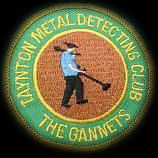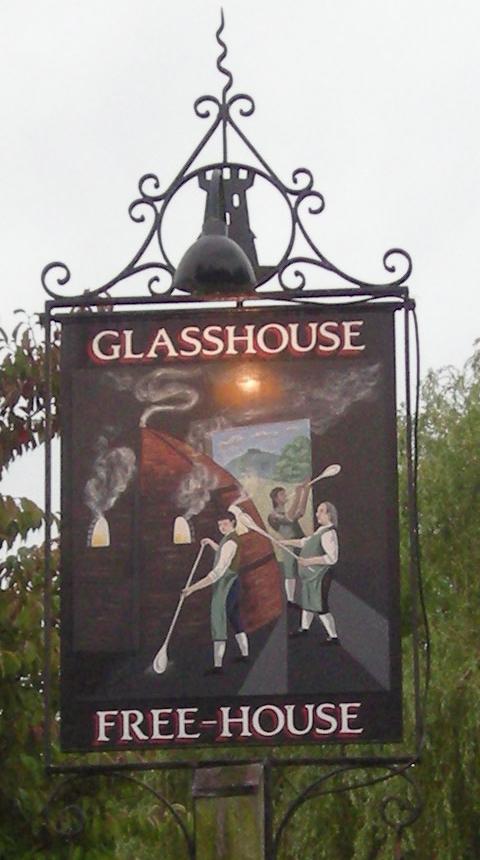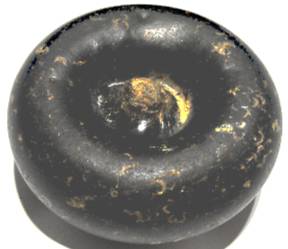
Taynton History
Parish History
The Dobunni
Roman Iron Making
Roman mosaic
Taynton Parva
St Lawrence Church
Glass Making
Brick Yard & Pottery
Brass Mill
WWII
Typhoon Crash
Hampden Crash
US Camp
US Finds
Taynton Metal Detecting Club
The Gannets
Glass Making

|
The Hamlet of Glasshouse On the left is the sign of The Glasshouse Inn, Taynton. A reminder of the glass industry that once operated in the locality. The hamlet of Glasshouse is one of a small number of glass making areas in Britain that were settled by immigrant glass workers in the late 16th century. Most of the hamlet lies within the Taynton parish boundaries, with the main glassworking site just over the border in the parish of Newent. |
Glass Finds
In 1968 Gloucester City Museum undertook an investigation of the glassworking site and collected many fragments of glass by field walking. Fragments of beakers, goblets, wine glasses, bottles and window glass were found. The club has subsequently found some of the distinctive light green glass in the plough soil together with a lesser quantity of pale blue glass, a few decorated pieces and various glass rods and tubes. The most complete article found is a linen smoother which is only missing its handle.

|

|

|
| Glass fragments. | Linen smoother. | Molten glass and crucible, with glass residue. |
History of the GlassMakers
One of the earliest references to the Glasshouse is for the year 1598, when Sir Jeremy Bowes obtained letters patent which said: "In Gloucestershire one Houx a Frenchman hath built a glasshouse and furnace and doth make great quantities of glass". In 1591 Queen Elizabeth I had granted Bowes a twelve year monopoly over the British glass industry and he was attempting to squash any illegal competition. Most of the families who settled at the foot of Yartleton Hill (May Hill) and began making glass were Protestants of French and Flemish origin known as Huguenots.
In the 16th century Europe was in great turmoil with people suffering repression and religious persecution. Thousands of families fled their country with many settling in Britain and among them were highly skilled glass workers. Some of these immigrant glass makers are known to have come from Normandy and Lorraine between 1567 and 1572 and perhaps escaped just in time for in 1572 twenty thousand French Protestants were massacred at what became known as The Massacre of St Bartholomew's.
Glass making in 16th century Europe was a highly respected profession, glassmakers were among the elite of society and even the nobility were involved in the industry. In England things were entirely different, with workers regarded as among the lowest classes, many lived in utter squalor. These differences were eventually to lead to great friction.
The history of some of the Huguenot glassmaking families who came to England and eventually settled in Taynton can be traced back to 1473 when they lived in the Darney area of Lorraine. Lorraine at that time was an independent border state between France and Germany and came under the jurisdiction of the Dukes of Lorraine. Some of the most prominent families were named Thysac, Hennezel, Thietry and Houx. There are many different spellings of these names in old records such as in the case of Tysac - Thisac, Thysac, Thise, and Tixot but they are known to be of the same family line. Glassmaking at that time was a very highly respected profession and the glassmakers had many special privileges. They were the elite of society being of noble rank equivalent to the status of a knight. One of their homes was a very imposing building built by Nicolas de Thysac in about the middle of the 16th century known as the Chateau of Lichecourt and it was the seat of the Thysac and the Hennezel families for several generations.
The special skills of glassmaking were passed from father to son and were a highly guarded secret; everyone involved had to swear never to divulge them. Ceremonies of ‘The Swearing of the Glassmakers Oath’ were held annually and had to be taken by any newcomers joining the profession. Intermarriage between the glassmakers families was commonplace, particularly amongst the Tysacs and the Hennzels, perhaps this was because of the need to keep the secrets within the family.
The Tysac’s seem to have been of a rather hot blooded nature for the history of their family records several ‘murders’. They lived in a very turbulent period of history when it was up to every man to defend himself. Being nobles they were allowed to carry swords and these were often used as a way to settle old scores or even petty quarrels. In October 1579 Christophe de Thysac killed his cousin Balthazar de Hennezel during a family argument and so he fled to England where he is believed to have died in about 1595. It seems that religious persecution and the odd murder were not the only reason why the Lorraine glassmakers left for England. Taxation became penal and this coupled with over production of their glasswares led to a severe decline in their industry.
On arriving in England some of the immigrants set up business in London in the parish of St Olaves and operated a glasshouse there known as the Crutched Friars Glasshouse. Among those glass workers were the Houxs and Thisacs (Tysacks), an exception among them was Henry Bridgman who was a native Englishman, with relatives in the Newent and Gloucester area. Whilst at St Olaves the Bridgmans produced a son; the local church registers there records that Henry the son of Henry Bridgman - glassmaker was christened on 23rd March 1594.
Although skilled men in their own right, they came under the influence of a master Venetian glassmaker named Jacopo Verzelini, and together they began to produce glass superior to the out-dated British products. Trouble flared as the old established glass makers began to lose trade to these newcomers. In order to protect their livelihoods the locals accused the foreigners of destroying the forests for the vast quantities of timber required to fire their kilns. The trouble makers were able to get the local iron workers on their side as they also needed the timber to make the charcoal for their furnaces. Threats were made to burn down the Frenchmen’s homes and even death threats were made, one glasshouse together with its kilns and equipment was completely destroyed by fire. As a result many of them left London in 1576 and moved to Buckholt in the forests of Hampshire, Staffordshire and the Weald of Sussex. In about the year 1590 they moved on again, to St Weonards, Herefordshire and into Gloucestershire; settling in Woodchester and to the Taynton.